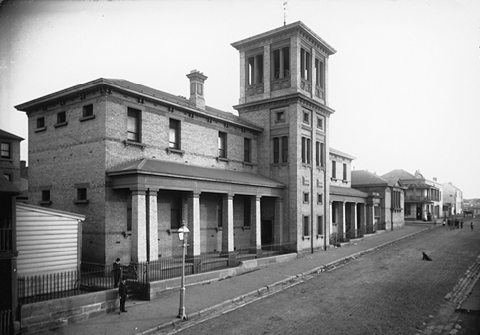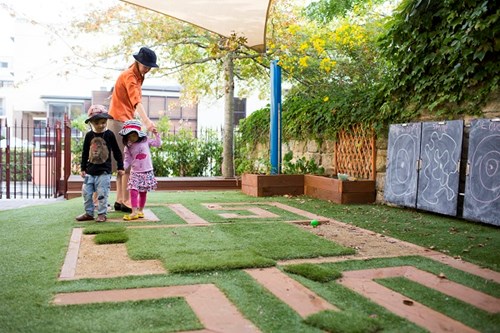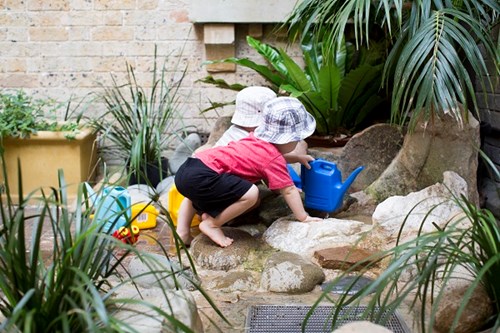Beginnings of SDN Pyrmont
‘It is a different place. And yet it is not. Just scratch the surface and the marks of past ways remain...’ Shirley Fitzgerald, 'Pyrmont', Dictionary of Sydney, 2008
SDN Children's Services begins in 1905
In 1905 a determined group of women from Sydney’s upper classes who understood ‘the difficulties that beset the paths of working mothers’ founded the Sydney Day Nursery Association. The Association aimed to improve the welfare of children whose mothers were facing poverty and had to work to provide for their family. Infant mortality was high and the Kindergarten Union was only able to provide day care services for a few hours a day. With no other option, these young children were often left to fend for themselves among the streets of working class Sydney.
In response, the Association opened its first Day Nursery in a terrace house in Dowling Street, Woolloomooloo in 1905, the first long day care centre in NSW. For just three pence a day, babies and children were bathed, fed, clothed and cared for from 7.00am to 6.30pm.
Due to overwhelming demand, the Association opened Day Nurseries in five more locations in the inner city. These were all areas of need in Sydney with large working populations.
History of Pyrmont
The traditional owners of the land are the Cadigal people of the Eora nation, who named the point ‘Pirrama’ which means ‘rocking stone’ [1].
The land was bought by Captain John Macarthur, a soldier, businessman and pastoralist, from a sergeant for a gallon of rum in 1799. The suburb of Pyrmont gained its name during a boating excursion in 1806. John Macarthur and his friends were enjoying a picnic in the area, when one of the party remarked that the natural water springs of the area looked like the German spa town of ‘Pyrmont’. John Macarthur then named the area the Pyrmont Estate.
The beautiful area eventually became subdivided and industrialised. Wharves allowed for trade to pass through, while the first steam-powered mill in Australia was established in Darling Harbour in 1815.
In the 1850s it was discovered that the sandstone in Pyrmont was of the very best quality, known as ‘yellow block’. Quarries were quickly established and the first Pyrmont Bridge built to transport the sandstone. Many of the older buildings in Sydney are constructed with Pyrmont sandstone, including Sydney Town Hall, the Art Gallery of NSW and Customs House.
By the 1900s, Pyrmont was an important centre of industry for Sydney. Shipyards, wharves, woolstores, timber yards, flour mills, iron foundries and power stations meant that a large and crowded working population lived in Pyrmont. The sweet smell of sugar was common in Pyrmont from the local Colonial Sugar Refinery!
Did you know? The building SDN Pyrmont is located in is the building that was Pyrmont Public School from the 1880s to the 1930s!

Pyrmont Public School c.1880-1900. Image used with permission by the Tyrrell Collection, Powerhouse Museum, Sydney.
Pyrmont Public School and beyond
Pyrmont Public School on John Street was built and designed specifically as a school in the late 1800s by William Kemp, NSW Architect for Schools.
The single storey school building opened in 1884, followed by the addition of the two-storey classroom building in 1892. The building is a good example of the Victorian Italianate style.
Local children were allowed to attend the Pyrmont Public School at the age of four, earlier than the statutory age of five, because many of the mothers were forced to find paid employment. An article in The Sunday Times, 12 November 1922, described the young children in the kindergarten: “Some of them have no boots, some no socks - most of them in rags”. The school tried to improve their lives, despite the factories and polluting chimneys that surrounded the children every day.
Pyrmont Public school closed in 1933 during the Depression, as industries and the population declined. The building became a hostel for soldiers on leave during World War II. By the 1950s many of the industries closed in the area.
From 1948-1990 the building was the Pyrmont campus of the Sydney Technical College. The building was eventually heritage listed by the City of Sydney in recognition of its importance to the history of school building design and its social role within the local community.

Children leading an educator on an exploration of SDN Pyrmont, 2014. Photographer: Anna Zhu
SDN Pyrmont opens in 1993!
The Sydney City Council approved the Sydney Day Nursery and Nursery Schools Association’s tender application to operate the Pyrmont Child Care Centre on 24 May 1993.
SDN worked quickly to open the new centre, recruiting its first Director from SDN’s demonstration Nursery School at Melanie Alexander, Newtown.
The centre was opened on 23 August 1993, with 20 babies and toddlers enrolled. This quickly grew to 40 babies to 5 year olds by January 1994.
SDN’s 1993 Annual General Meeting was held at Pyrmont to introduce the SDN Community to the Association’s new centre.
About the same time, the City Council established the Pyrmont Community Centre in the old school building, which is still there today. The Pyrmont Nursery School occupied the ground floor of the building. The names for the children’s groups were ‘little mice’, ‘big mice’, ‘little elephants’, and ‘big elephants’!
Within the first year the children enjoyed a puppet show, trip to the zoo and Powerhouse Museum, visits from Sydney firefighters and a mobile animal petting zoo.
The Parent Committee of the Pyrmont Nursery School helped with fundraising, including a cake stall at the Pyrmont and Ultimo Festival, and organising SDN Pyrmont’s first birthday party on 19 August 1994.

Playing in SDN Pyrmont, 2014. Photographer: Anna Zhu
SDN Pyrmont today
In 2013, the City of Sydney restored the façade of the old building. The building is an important landmark in the area and to the community of Pyrmont. The restoration means it will continue well into the future to be part of Pyrmont’s heritage that remains connected to the care and education of children.
Since its beginnings, SDN and the suburb of Pyrmont has undergone many changes. SDN Pyrmont still reflects a strong connection with our families within this vibrant and diverse community.
The changes in the sector to increase the quality of early childhood education and care have confirmed our own approach to professional skilled staff and services since our beginnings.
What hasn’t changed is our vision and commitment to addressing social inequalities, improving children’s quality of life and enhancing the life chances for all children.
About this history and the SDN Archive
This history was put together from documents held in the SDN Archive, and information from City of Sydney, Dictionary of Sydney and Powerhouse Museum. The SDN Archive, established in 2002, is a unique resource in Australia’s early childhood education sector. SDN Children’s Services runs 26 children’s education and care centres throughout NSW and the ACT, as well as offering disability services for children and young people, and delivering government funded programs supporting children and families and other sector organisations.
[1] Source: Sydney Harbour Foreshore Authority.

